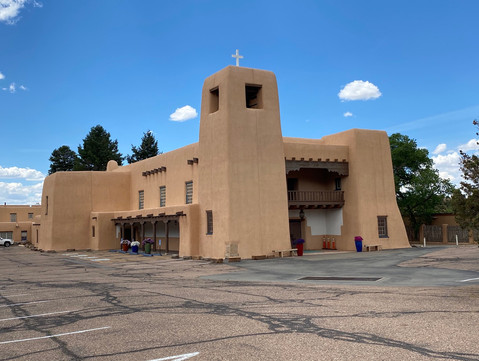As COVID "watch and wait" continued, we relocated to Santa Fe, New Mexico in early May. As noted in a previous post, we'd enjoyed our time in Tucson, but it was getting too hot (100 degrees plus every day) for us to consider staying. With Santa Fe's elevation of 7,000 feet, we knew we'd have more moderate temperatures (highs in the 70s and low 80s).
The elevation also meant changes in vegetation, even though we were still in the desert. Unlike Tucson, where cactus dominates (1st photo), the Santa Fe hillsides (2nd photo) are covered with low bushes, including fragrant desert sage and small pines trees.


There are some cactus in New Mexico, but they tend to be much smaller than their southern counterparts. perhaps due to the higher elevation.

There are also flowering this time of year, and surprisingly their flowers are the same size as the larger prickly pear cactus in Tucson.
We appreciated the fact that local wildflowers were on full display.
New Mexico was on COVID lockdown during our time there, so our activities were limited primarily to hiking in the Santa Fe area.
We stayed at Santa Fe Skies RV Park, a place we'd spent a couple of days when we first came west in April 2019. It sits on a hilltop at the south end of Santa Fe. It has a great 360 degree view of the mountains in the distance - some still had snow in the upper elevations when we first arrived. In addition to campsites for RVs, the park hosts a collection of old farm machinery and also outdoor metal sculptures (which are for sale). The local metal sculptor' art installations feature reclaimed materials - using everything from bike handlebars to machinery parts to oversized metal tractor treads. The campground also had a hiking trail (0.75 miles) looping around the outside.
The great view comes with a price - the campground is buffeted by strong winds that can wreak havoc with awnings and slide-outs. At times the wind was so strong that we took in our slide and we could still feel our little house being rocked by the wind.
We're not sure whether they have architectural covenants in Santa Fe, but everything (and we mean EVERYTHING) had an adobe vibe going on.
Scenic roads lead both north and south from Santa Fe. One, called the Turquoise Trail, leads south through small art towns and winding hills. We traveled it, and also took a side road up to the top of Sandia Crest, which offers a beautiful view of Albuquerque laid out below.

About 15 miles south from Santa Fe we spent time hiking in Cerillos Hills State Park. Native Americans dug for turquoise there 1,000 years ago, and Spaniards and later settlers dug a number of mines there for other minerals.
Heading north from Santa Fe, we drove the beautiful High Road to Taos, which passes through high desert, forest, and mountains.



Taos is a popular ski town in the winter, and there was still a bit of snow on the peaks. The town itself, however, was locked down like Santa Fe.
Taos sits at the foot of the mountains in a wide valley formed by lava flows millions of years ago. Since then, the Rio Grande river has carved a canyon through the valley. This area is part of Rio Grande del Norte National Monument.

We hiked two miles down from the highway to the edge of the rift gorge.



[Being in lockdown has also given us some time to experiment with the photo post-production software we sometimes use. See examples below.]


Another day, we explored the Rio Grande from inside the gorge. We were able to see up to the viewpoint we'd hiked to previously.


Driving back up onto the plateau, we crossed over the Rio Grande Gorge Bridge, one of the ten highest bridges in the U.S., sitting over 650 feet above the river.



Los Alamos (of atomic bomb fame) is about a 30 minute drive west of Santa Fe, and offered some lovely hiking opportunities, including walks along gorges, through pine forests, and atop mesas.








The drive to Los Alamos passes through several different Native American pueblos, and showcases some decorated overpasses.
On that same drive, you pass by Camel Rock, a notable landmark. One of the local casinos is named after it.

Going 30 minutes east of Santa Fe, we visited Pecos National Historic Site. It includes the ruins of an ancient Native American pueblo (including ceremonial kivas), a Spanish adobe church ruin, and even a Civil War battlefield (when the Confederate state Texas tried to seize control of a trade route to Union state California).




Although Santa Fe is in the desert, we did get rain and thunderstorms while visiting. You can see bad weather approaching from far off out here.



As we said, our stay in Santa Fe was mostly about hiking and exploring the natural beauty of the area. We'd love to go back when the museums and shops are open.
By the beginning of June, things were starting to open up again (albeit slowly) out west, so it was time for us to get on the road and start exploring again. More about that in our next blog post!

















































Santa Fe looks amazing, especially the beautiful cactus flowers. Your pictures are just gorgeous. Interesting to see Walmart with an adobe look. So glad you are making the best of the pandemic and enjoying the US. I really enjoy your blogs and they give me hope. :) Continued safe travels and please post lost of pictures of the Grand Canyon.